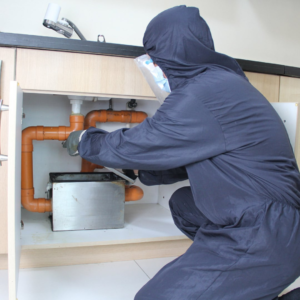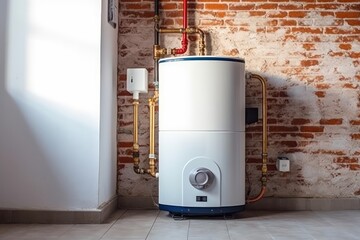Any restaurant must keep kitchen grease waste out of the sewer system. Grease traps must be pumped regularly to prevent them from reaching capacity and overflowing.
A grease trap — or grease interceptor — is a receptacle that kitchen wastewater flows through before entering the sewer waste system. They’re one of the leading causes of sanitary sewer overflows. Contact Grease Trap Perth now!

A grease trap is a plumbing system that separates fats, oils, and greases (FOG) from the wastewater from your kitchen sink. This prevents the FOG from clogging and damaging pipes and drains and helps ensure your establishment complies with local sewage regulations. A properly maintained grease trap will help prevent overflows, backups, and other expensive problems.
Grease traps come in various sizes, from small variations designed to connect individual sinks to larger versions that can accommodate entire facilities. Your business’s production volume, space availability, and other factors will help determine which type of grease trap is best for you.
Most municipalities require restaurants to install and maintain grease traps to protect the sewage system from oil and food solids that can clog and damage drains, sewer lines, and other plumbing systems. Because of this, most cities require restaurant owners to regularly have their grease traps cleaned and emptied to prevent overflows and other costly issues.
A grease trap needs to be sized appropriately and installed in the correct location for it to work correctly. A small or residential grease trap may need to be bigger to handle the waste from a busy commercial kitchen, while an industrial-sized system could overload the sewer line and cause overflows. It is also important that the grease trap be located in a suitable spot, such as outside or in an area where it can easily be accessed for cleaning and maintenance.
While there are many different types of grease traps available, most operate in similar ways. Wastewater from kitchen sinks flows into the trap, where it passes through an inlet pipe and is filtered by baffles. The wastewater then flows out through an outlet tee, where it enters the regular sewage system. The FOG in the wastewater is separated from the clean water and pumped away by grease pumping trucks on a scheduled basis. The resulting brown grease is collected and recycled for use in making animal feed, cooking oil and other uses, rather than being sent to landfills.
While it is possible to install a grease trap yourself, the process can be messy and complicated if you don’t follow all the instructions carefully. For this reason, it’s often best to hire a professional plumber who specializes in grease management services.
Why Install a Grease Trap?
The installation of a grease trap is a smart investment for commercial food businesses. These systems prevent costly clogs that can damage the plumbing and sewer lines of an establishment, as well as the surrounding city infrastructure. The best part is that they can help to protect the environment as well by preventing FOG from entering local rivers and streams.
Grease traps are designed to filter residual fats, oils and greases from wastewater as it leaves kitchen sink drains. However, it is important to remember that FOG should never be poured down a drain. This is because it will solidify as it travels through the pipes, which can cause clogs, backups and overflows. In addition, it can also cause problems with the local city sewage system and result in fines for the business owner.
Regular maintenance is essential for a properly functioning grease trap. This includes routine inspections, cleaning and pumping. It is recommended that these services be performed by a professional plumber. This is to ensure proper installation and compliance with local plumbing codes and regulations.
Another benefit of having a grease trap is that it will help to keep other drains in your restaurant clean. This is because the trapped FOG will have to work hard to escape the trap, which will prevent it from working its way down the other drains in the kitchen.
FOG accumulation is a major contributor to thousands of sanitary sewer overflows in the United States every year. FOGs are generally carried by waterways into lakes, streams and rivers, where they can affect the health of local aquatic life. Having a properly installed and maintained grease trap can help to prevent these FOGs from reaching the public water supply and causing contamination.
Having a grease trap can be an effective and affordable solution to the problem of FOG build-up in your restaurant. However, it is essential that you have your grease trap inspected and cleaned regularly to avoid costly problems. In addition, you must make sure that the collected FOG waste is disposed of in accordance with local regulations.
Grease Trap Installation
Fats, oils and greases (FOG) are a leading cause of clogged sewer pipes that can lead to costly repairs, environmental damage, and hefty municipal fines. Thankfully, restaurants and food establishments can prevent FOG from entering the municipal wastewater system by installing and maintaining grease traps. Despite their pivotal role in protecting sewer systems and the environment, many establishments are unsure about how to go about establishing and managing a grease trap.
The process for a commercial kitchen to install a grease trap typically begins with sizing and obtaining proper permits. The next step involves finding a suitable location for the grease trap, where it can be easily accessed for maintenance and cleaning. The final step is coordinating with the local plumbing authorities to ensure that all necessary requirements for installation, maintenance and inspection are met.
Once the grease trap has been installed, it is crucial to educate staff on how to properly use and dispose of food waste in the kitchen. This includes using drain covers, scraping dishes into trash before rinsing, and avoiding pouring greasy cooking oils and food waste down the drain. Regularly checking the grease trap for any signs of clogging can also help prevent problems in the future.
While some businesses are able to perform the installation of a grease trap on their own, it is recommended that professional plumbers be hired. A plumber with a thorough understanding of plumbing codes and regulations can ensure that the installation process is completed correctly. In addition, a professional can also provide advice on the most appropriate type of grease trap to best meet a business’s needs and ensure compliance with local rules and regulations.
When a grease trap is improperly installed, it can lead to frequent clogs and backups that impact a restaurant’s operations. It can also increase maintenance costs and lead to non-compliance with regulatory standards that could have serious consequences for a restaurant’s reputation and bottom line.
It is important to find a reputable grease trap service provider that offers a variety of pumping methods. Some options include a “pump and return” option where your grease trap is pumped dry and the separated gray water is returned to your trap; this is considered the most environmentally-friendly method. Other services may involve removing the FOG material and hauling it away separately from the gray water, which can cause strong odors until the trap is refilled.
Grease Trap Maintenance
A properly functioning grease trap is a critical component to a restaurant’s operation. It helps ensure cleanliness in kitchens and food safety for customers. Additionally, it supports environmental sustainability efforts by preventing FOG contamination of waterways and helping minimize the carbon footprint involved in wastewater treatment processes.
Grease traps must be cleaned regularly to maintain optimal functionality. A regular cleaning helps prevent foul odors and clogs, which can disrupt your restaurant’s operations and lead to sewage backups and expensive repairs. Additionally, a regular cleaning can help you avoid fines and other penalties from local health and sanitation authorities.
In addition to cleaning, regular inspections of your grease trap are important to catch any damage or potential issues early on. During the inspection process, professionals can check for issues like wall corrosion and broken filters that could impact your grease trap’s ability to function effectively. Professionals can also provide recommendations on any necessary repairs to your trap and interceptor.
During a cleaning service, professionals will pump your grease trap to remove the hardened fats, oils, and greases that have accumulated inside. This process helps reduce odors, improves the effectiveness of your grease trap, and prevents costly repairs or replacements down the road.
Cleaning a grease trap also involves scraping the walls and baffles of the device to remove adhered grease thoroughly. This can be time-consuming and labor intensive, but it is essential to ensuring that your grease trap is free from blockages and working properly.
Professional cleaning services can also include line jetting, which is one of the most effective methods for cleaning grease traps and interceptors. With this method, a highly-pressurized hose is sent down the plumbing, blasting away clogs and washing grease into the municipal sewage system.
Getting a professional to perform your restaurant’s grease trap maintenance and cleaning is the best way to ensure that the device is cleaned at the right intervals and keeps operating efficiently. Not only do experienced professionals know how to keep your facility compliant with state and local regulations, but they also can take the hassle of paperwork and inspections off your hands.
